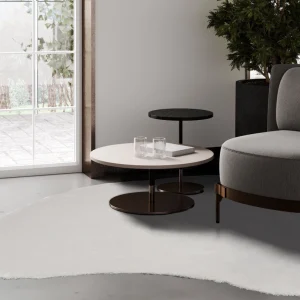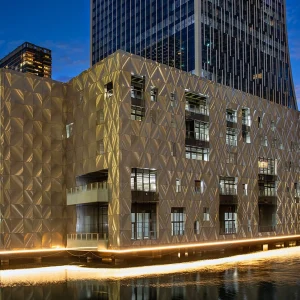
Consumerism was one of the driving forces of the Fifties to late Sixties. It fuelled not only the new art, subsequently known as pop art, but motivated the mass market of consumers to seek new objects of desire: beautiful, sleek, curvaceous, glossy things to own now! Household goodies and glamorous cars offered a fresh, modern lifestyle, all presented and transmitted by new modes of communication. This was the ‘pop world’, which in the UK was inextricably bound to music and fashion. It caused a profound social and cultural shift.

Richard Hamilton’s 1956 collage Just What is it That Makes Today’s Homes so Different, so Appealing? — a reproduction of which is on show at the Barbican’s Pop Art Design — is widely acknowledged as the first pop art piece. His examination of new types of imagery drawn from 20th-century media, chiefly American technology, popular entertainment and modern mass communications, especially TV and advertising, lays the basis for most pop art. Hamilton said that to be pop art objects had to be ‘popular for a mass audience, transient, expendable, low cost, witty, sexy, glamorous and big business’. This was true for pop art in both the United States and the UK, despite their very different roots.
Without the curator Catherine Ince’s British additions and a section on women it would have been historically inaccurate

Pop Art Design includes iconic and lesser-known art works by artists including Clive Barker, Peter Blake, Judy Chicago, Richard Hamilton, Allen Jones, Roy Lichtenstein, Claes Oldenburg, Joe Tilson and Andy Warhol. It principally includes furniture by Italian designers Gaetano Pesce and Ettore Sotsass, and a number of American designers from the Fifties, who designed for Herman Miller (and hence whose works are now part of the Vitra collection), such as Charles and Ray Eames, George Nelson and Alexander Girard.

The exhibition is the brainchild of the Vitra Museum’s previous curator Mathias Schwartz-Clauss, who wanted to demonstrate the links between many of the pieces in its collection and pop art. Reinterpreting works to suit his own thesis, he has rather over-egged the pudding, for example much of what Ray and Charles Eames produced is presented under the banner of Pop Design. While the Eameses were without doubt chronologically the precursors of pop-art designers, their aims, values and ideas were patently different. They wanted to reach that mass market, but not for ironic reasons. They created new shapes not to echo pop art symbols, but because emerging technologies and materials — principally plastics — meant they could evolve new forms and could also make them colourful.

In fact the USA was not where pop design first emerged — nor till later, did they in Italy. It was in the
UK that pop art and design had the closest links, in part because London’s Royal College of Art was the incubator for many of the pioneers of the movement (think Peter Blake, Derek Boshier, Allen Jones.) It was also home to pop designers such as Peter Murdoch and Roger (Dixie) Dean. The UK of the Swinging Sixties was a world where art, product, graphic and fashion design, film and music interacted without restraint. It was here that the influence of fine art on design and vice versa were most in evidence, not in the USA. Italians such as Gaetano Pesce, Studio 65 and Sotsass developed pop-art furniture pieces late in the Sixties and early Seventies, and the exhibition has several splendid examples.

Originally presented at the Vitra Design Museum, Pop Art Design was developed in cooperation with the Louisiana Museum of Modern Art, Moderna Museet and Barbican. This is the most expansive version, and Barbican curator Catherine Ince has added greatly to the original by including British pop artists such as Joe Tilson, Peter Blake and Eduardo Paolozzi and a limited amount of British design, such as Peter Murdoch’s polythene-coated paper table and chair Those Things from 1968, Bernard Holdoway’s 1966 Tomotom card-and-chipboard table and chairs, paper dresses by Harry Gordon, and a raft of graphics.
Although Mathias Schwartz-Clauss did not want to include fashion or music, the mutual interaction of art and design occurred in large part through both fields; Ince’s additions are therefore crucial. Pop Art Design, designed by AOC Architects, has much to offer, but some of it is misleading. There is too much reliance on Vitra, in terms of what it makes or holds in its museum, rather than what is seminal. Without Ince’s British additions — as well as a significant section on the contribution and depiction of women — it would have been historically inaccurate. It is nevertheless enjoyable and colourful. Works that today might be considered heirs to the pop art tradition, such as the giant Koons on show with the Gagosian at Frieze, are more cynically exploitative. What was unique about art and design then was their inherent mix of exuberance, optimism and criticism for and of possible lifestyles.
Words by Corinne Julius





